This post may contain affiliate links. We may earn money or products from the companies mentioned in this post.
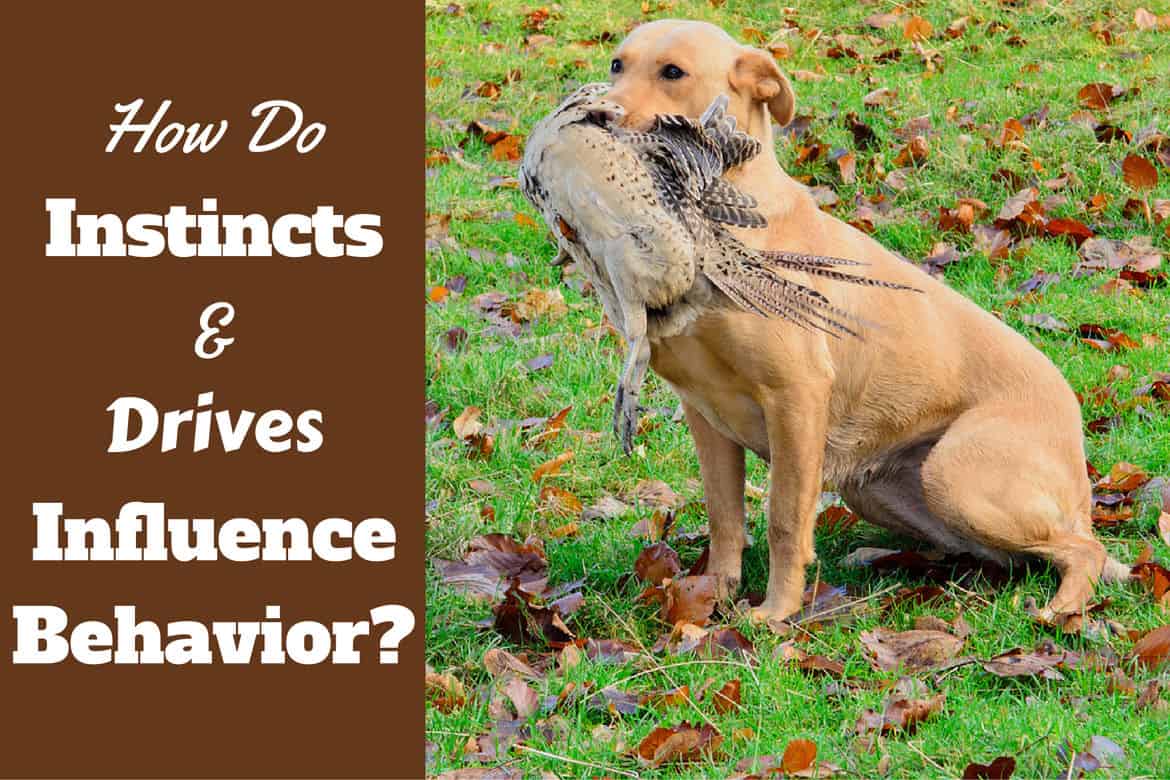
Although many talk about dog instincts and drives as if they’re the same thing, there is a subtle difference.
Drives are strong, compelling, almost irresistible urges that spur a dog into performing a particular action. Such as the drive to eat (food drive) or the drive to reproduce (sex drive).
Instincts are natural abilities a dog’s born with that allow it to perform a task without having had to learn how. Such as the instinct to suckle (satisfying the food drive) or the instinct on how to mate (satisfying the sex drive).
Drives are the motivation, while instincts are the ability to do something.
Learning the natural instincts and drives that your Labrador Retriever has is a very important step to take towards understanding your dog.
Why Learn Your Labradors Instincts and Drives?
By having at least a little knowledge of dog instincts and drives, you can begin to understand the reasons behind certain behaviors and use this to help you in your training methods.
Some behaviors are undesirable, maybe even dangerous for you or your lab. They must be redirected into acceptable, safe behaviors that still offer a release for your labs pent-up, driven energy.
But there are natural behaviors that although we find ‘uncivilized’ we should just let be and should never attempt to change.
For example, smelling the anal scent glands of other dogs or smelling feces is undesirable to us, but to your lab they’re essential ways to interact with and understand the world in which he lives.
These instinctive behaviors are part of what a dog is and to deprive your lab of these behaviors would be to deprive him of being a dog!
This is why you as a Labrador owner should understand and recognize natural canine behaviors.
You need to learn how to redirect unwanted behaviors whilst allowing some behaviors that are completely natural and essential to your dogs well-being and should never be taken away.
The first step toward this is knowing what the natural dog instincts and drives actually are.
Not Everybody Agrees on the Number and Type of Dog Instincts and Drives
Researching for a few hours on the web, I’ve discovered differing opinions on what is and isn’t a drive and the number of them that a dog possesses.
This is why, rather than linking to a single resource, I decided to write this article, summarizing the best of what I found.
Although not everybody agrees on the number of drives, it’s pretty much agreed which behaviors particular drives result in and how important it is we understand this.
12 Dog Instincts and Drives Your Labrador Possesses.
What follows is my summary on the more important and most commonly seen drives we see in our dogs and how they motivate certain behaviors.
At the end of the list I’ve linked to a number of articles I found helpful so you can read in more detail if you’d like further information.
Pack Drive
Labradors have a high pack drive, making them naturally very social animals and happiest living within a pack environment.
Dogs with a strong pack drive will have a very strong desire to be with their family, constantly following their owners around, begging for attention, play time and seeking out affection.
This is why they are so loving and real ‘people dogs’.
A high pack drive makes them relatively easy to train as they’re eager to please to earn attention and praise.
But a downside of some dogs with a strong pack drive is separation anxiety, often resulting in the dog relentlessly barking and whining when left alone and sometimes leading to obsessive and destructive behaviors like chewing things they shouldn’t.
So it’s important to train a Labrador that time alone is OK from an early age before these problems develop.
Food Drive
One of the strongest dog instincts and drives. Like all living animals, a dog must eat to survive.
And though they’ve no need to hunt and scavenge (as you give all the food they need) most dogs still will as they’ve natural urges to do so.
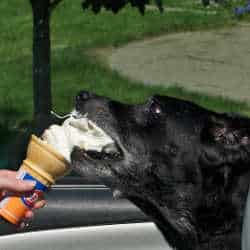
Dogs with low food drive can be picky eaters and aren’t willing to perform a task merely to receive a treat. But not your lab…
Labrador Retrievers generally have a VERY high food drive and will vacuum up all the food you could ever offer.
This high food drive adds to their trainability because the urge to get a tasty treat is so strong. They’ll try their best to do whatever you ask to get at the treat. And with careful planning in building their food drive, you can heighten this drive and improve their trainability.
But a downside to a high food drive is the potential for an overweight dog. I see many overweight Labradors around where I live. This is due to their high food drive…and owners giving in too easily to begging!
Retrieve Drive
Very high in Labrador retrievers as you would imagine from the name of the breed. The retrieve drive is the desire of a dog to bring back items to their pack or their owner.
Personally, from my research, I believe the retrieve drive is a mix of the Labradors prey, hunting, and pack drives and not a drive in itself.
The hunting and prey drives are what makes your Labrador want to retrieve an item, the pack drive is the urge to bring back the spoils to its owner (or pack).
But this is my opinion only and some mention it as a drive of its own. And hey, I couldn’t leave this out in an article devoted to our beloved Labrador retriever!
If ‘retrieve’ is an individual drive, then a Labradors is very strong and you will almost certainly find that you will tire of games of fetch long, long before your Labrador ever will.
Play Drive
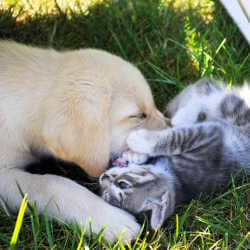
This is your dogs desire to have physical fun with it’s owner or other animals.
Puppies are naturally born with a very high play drive, but most dogs grow out of it as they become more mature. However, well socialized and happy Labradors tend to keep their play drive well into adulthood.
Whereas most breeds tend to reach adulthood at 18 months or so, it’s often said that a Labrador is pretty much still a puppy until it’s 3 years old. This statement comes from the labs high play drive that often remains for longer than other breeds.
The high play drive in Labradors is a good thing. For one, as well as food, it enables you to use play as a reward in training. Secondly, well, just because it’s pure fun for you to play with your beautiful lab! :-)
It’s possible to increase (or keep) the play drive in your lab right into adulthood by regularly engaging in play sessions. And I for one will certainly try to do exactly that.
Prey Drive
Prey drive Is responsible for behaviors related to chasing, catching and killing prey.
Chasing fast-moving objects such as passing motorcycles or squirrels in the park, games of tug, shaking items vigorously in their mouth as if to ‘kill it’ are all behaviors stemming from this drive.
Generally speaking, Labradors have a strong prey drive. But they can readily be trained to keep it in check by actively redirecting unwanted prey drive behaviors with hunting style games.
We can channel the drive into games of fetch, chase and tug with a rope, whilst actively discouraging dangerous chasing and catching of bikes or small animals for safety. Or you could take your Labrador gundog training?
Defense Drive
This is the most important drive for any wild animals survival and stems from the fear a dog feels when facing a potentially threatening situation.
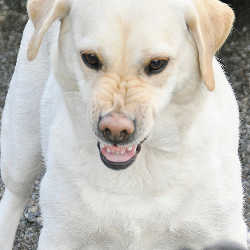
It’s commonly described as the ‘fight or flight’ response, which are the two actions a dog will take when faced with a threat:
Fight Drive is strong in dogs considered confident and aggressive in stressful situations. A dog with a strong fight drive will stand his ground, guard their ‘pack’ and territory, seem ready to fight and will not back down when challenged.
Flight Drive is strong in dogs considered shy / nervous. A dog with high flight drive doesn’t look confident in new situations. They may run to hide behind their owner or dash out of sight when scared or challenged.
Dogs experiencing ‘defense drive’ are stressed and fearful of whatever’s happening right now.
All but the most aggressive and dominant dogs will ultimately flee or show avoidance behaviors if possible, but a dog in this state that’s cornered has a higher chance of biting. So learn to recognize the signs and avoid such situations.
Territorial Drive
A dog with a high territorial drive will try to protect their family and property by scaring away any threats or trespassers with aggressive barks and growling.
It’s a drive most welcome in guard dogs but can become a nuisance if your dog barks at the doorbell, the mail man or a person walking by the foot of the garden.
It’s often a good idea to discourage and ‘train out’ this behavior when seen because it won’t take long for your neighbors to tire of a loudly barking Labrador.
Guard Drive
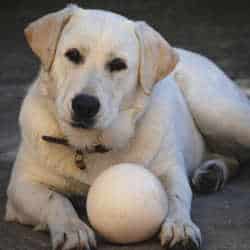
This is the drive from which the problem of ‘resource guarding’ stems.
Dogs high in guard drive will be protective of their possessions such as toys and fa favorite food. If you approach when they have a high value resource, they will show their teeth and growl. If you don’t back away, they may become aggressive and even bite you!
It’s natural to want to guard resources in the wild because you never know the next time you’ll be able to find food. There are often times of scarcity.
But this behavior is unnecessary as we give our labs all they ever need and resource guarding is dangerous when living in a human world if they do go on to bite.
So it’s very worthwhile you training your Labrador that resource guarding is unnecessary. There is always more to come.
This is a common trait in Labradors, but is easily trained out of them with the right approach.
Herding Drive
As the name suggests, dogs with this drive love to herd and have a strong natural urge to keep their pack together, knowing where they are, under their ever observant gaze.
Highly desirable in dogs bred for herding purposes such as keeping flocks of sheep together, but dogs high in this drive are known for nipping the heels of people the dog sees leaving the pack in attempt to keep everyone together.
Labradors aren’t naturally high in this drive.
Hunting Drive
This is an urge in some dogs to search for and find an object by any combination of it’s smell, sight or sound.
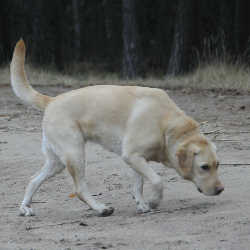
Labrador retrievers have a high hunting drive and were bred for this purpose. They have a powerful sense of smell that enables them to scent and track an object until they find it. And this is a job they truly love.
If your lab isn’t destined to enjoy the thrills of field / hunting work, then you can satisfy the hunting drive by hiding an object, such as a toy or some of their favorite food, then letting them tirelessly search for it by the use of their powerful sense of smell.
Protection Drive
This is a dogs drive to want to protect and defend the members of its pack.
The stories you hear of a dog defending its owner against a would-be attacker whilst out walking is a result of a dog with a high protection drive.
This is one of the weaker dog instincts and drives found in a Labrador, they’re just too loving and friendly to all. They’re far more likely to want to lick any attacker to death!
Sex Drive
The main purpose of life is to reproduce and pass on your genes to the next generation. All animals have this drive and your Labrador will be no exception.
If your lab is being sexually driven you may find it humping or mounting you, other dogs or stuffed toys, especially during play when it’s feeling excited or aroused.
We can only either satisfy these urges by allowing our lab to mate, or we can dampen it’s desires by spaying / neutering which has the effect of making hormonal changes.
But you will never be able to completely remove the sex drive of a dog that is ‘complete.’
Is That All of Them?
Well…no. This list is by no means a comprehensive list of all dog instincts and drives. There are others mentioned in the articles I stumbled across such as:
- Rank drive
- Subordinate drive
- Activity drive
- Avoidance drive
…And more besides!
However, I’ve covered the most important ones and hey, this article’s gotten way too long as it is (sorry)!
For those interested in some further reading, following is a few of the articles I read when researching this article:
- What drives your dog? – SiriusK9training.com
- Drive and instinct: Harness the benefits for training your dog and you! – training-your-dog-and-you.com
- Instincts and drive control our dogs – www.doglistener.co.uk
What You Should Take Away
Dog instincts and drives are the result of 10s of thousands of years of evolution.
They’re genetically inherited urges and skills that work to make sure the number one purpose of any animal in life is achieved: To live, survive and pass on their genes to the next generation.
Drives can be strengthened and developed in your lab and used to bring out wanted behaviors, but unwanted ones are very hard if not impossible to completely get rid of.
The key to developing a well-adjusted Labrador is finding a balance between his natural behaviors and the pet you would like him to be.
Accomplish this by finding alternative means for your lab to release the pent-up energy associated with his powerful drives.
It’s important to understand your labs right to behave like a dog. To make sure his natural needs and urges are properly satisfied, but without problem behaviors becoming common.
Activities such as hiking, hunting, retrieving, the odd game of tug, playing chase and sniffing out hidden objects will channel your dogs drives into truly fulfilling activities that will satisfy your Labradors psychological needs as a dog.
Anything To Add?
Do you have any questions, comments or anything to add to what’s been described above? We’d love to hear from you in the comments section below.
Disclaimer
All content on this site is provided for informational and entertainment purposes only. It is not intended to be nor can it be considered actionable professional advice. It must not be used as an alternative for seeking professional advice from a veterinarian or other certified professional.
LabradorTrainingHQ.com assumes no responsibility or liability for the use or misuse of what’s written on this site. Please consult a professional before taking any course of action with any medical, health or behavioral related issue.
Save to Pinterest:
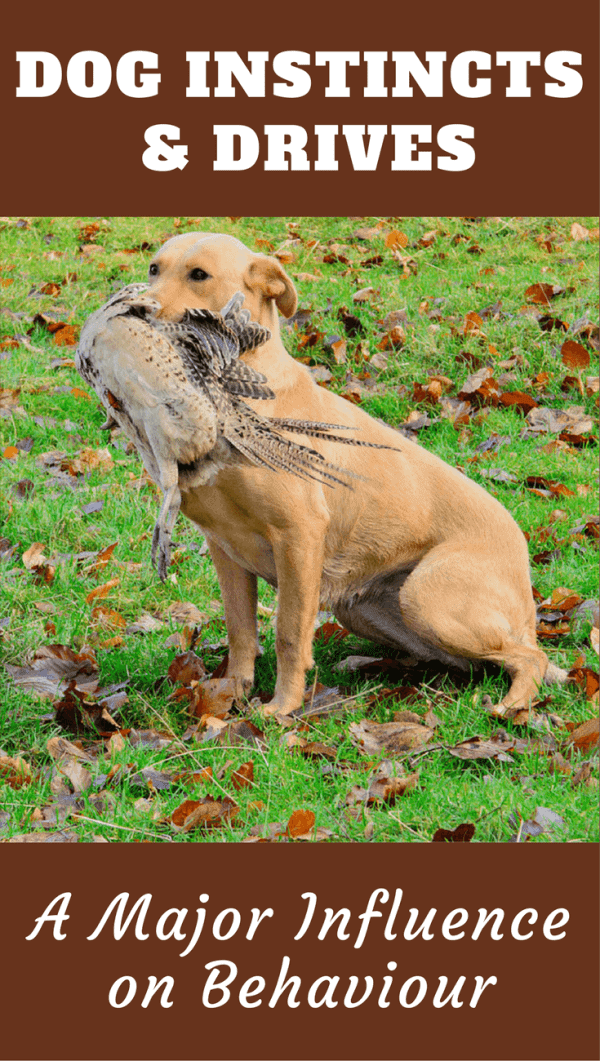
Top Picks For Our Dogs
- BEST PUPPY TOY
We Like: Calmeroos Puppy Toy w/ Heartbeat and Heat Packs - Perfect for new puppies. Helps ease anxiety in their new home. - BEST DOG CHEW
We Like: Bones & Chews Bully Sticks - All of our puppies love to bite, nip, and chew. We love using Bully Sticks to help divert these unwanted behaviors. - BEST DOG TREATS
We Like: Crazy Dog Train Me Treats - One of our favorite treats for training our service dog puppies. - BEST FRESH DOG FOOD
We Like: The Farmer's Dog - A couple months ago we started feeding Raven fresh dog food and she loves it! Get 50% off your first order of The Farmer's Dog.
For a list of all the supplies we get for our new service dog puppies check out our New Puppy Checklist on the PuppyInTraining.com blog.
12 comments
Mark
doing research today as my 18 month old female lab Mac tried to bite me yesterday. She has lots of toys and 1 or 2 of them she is very protective towards, me being “pack leader” thought it would be a good idea to take the toy from her every-time she started to show signs of aggression, yesterday it backfired and she bit me….
She is such a loving, loyal and friendly pet, she gets lots of exercise and generally shows a really good temperament, fun loving and very cuddly. We have only had her for 3 months and couldn’t of wished for a more loving companion. We brought her privately via the internet and are not sure she has had such a great life so far, the family we got her from said they didn’t have time to look after her and this showed as she was very over weight, they also had children which we suspect would take her toys from her and now she feels she needs to protect them at all costs.
Very good article, definitely one of the best i have come across today.
Will be changing my technique!!!
Will.
Hi Will,
By taking your toys from her, you could be making the problem worse by way of ‘negative re-inforcement’. She’s fearful you’ll take her stuff away and then boom! You do. So next time she’ll be doubly worried :-( So I don’t recommend this.
First things first, as a warning to anybody that may be reading, you shouldn’t shout at and punish your dog for growling…I’m not saying you do Will and am sure you don’t, I’m just stating this for the benefit of others that may be reading.
The reason for this is because growling is your dogs polite way of saying ‘Leave it out mate!’. She’s warning you, politely, to sop whatever it is you’re doing. In your case, attempting to take her stuff. If you were to punish her for this, she may not learn to stop guarding her stuff and being fearful of it being taken away, she may learn instead that growling gets punished and learn to stop growling. She will then go straight from being fearful right to biting without any warning. Obviously you do not want this.
Growling is normal behavior, not pleasant, but you do not want to stop it as it’s valuable communication between a dog and humans. What you want to do is treat the cause of the growling, to train acceptance from her and train an alternative behavior for when the growling and resource guarding occurs.
It sounds to me like you’re a good, responsible owner and are researching to be able to do just that. Good to see Will :-)
I have your e-mail address from your comment and will send over something I’d like you to read that may help, it’s too big to paste into a comment here.
Thanks for commenting and the kind words regarding the article. Much appreciated :-)
To stop toy or food aggression, you need to teach your dog/puppy that giving up the object results in a bigger reward. In other words, everything your dog becomes possessive, go get some hamburger, steak or a hotdg and do a reinforcement trade.
Excellent info explained clearly and easy to understand. I now understand labs behavior and their instincts. Have had several Labs and plan on adopting a rescue Lab before the end of the year. Do you think some dog foods and treats can cause cancer in dogs?
Hello,
I recently adopted a 2 year old male chocolate lab who is not fixed (he is AKC certified so I believe at one point they were going to breed him-I am not sure what we should do, I don’t know if we would want to fix him if it will alter his personality because he does not seem to be agressive towards people or other dogs from what we know).
His previous owners are in the army and had their sister watching him since July but she told them it was time to find him a permanent home where he can run around outside as she has a small yard and already has two boxers and two small children. This dog is such a lover to people, very good with children and gets along well with other dogs. There was only one hesistation-the sister watching him was unsure if he had ever been introduced to cats.
We live on an acreage and I have 4 kittens around 5 months old. So I had been doing research on how to introduce them by scentswapping before he got to meet them. Well the first day we had him of course it didn’t go the way I planned. First off, within the first 5 minutes he was able to chase a bird and killed it..it took one person holding his colllar and me prying his mouth open for him to drop it. He didn’t even shake it around, he just grabbed it and proudly pranced around for everyone to see. So this of course made me very nervous to introduce him to the kittens.
Well we were on our back deck and the kittens were in a closed room and all the sudden we heard a clatter and they had knocked the screen out of a low window and were standing on the window sill. I was frantic as the dog (Harley) had run down the steps and was standing right in front of them as they were frozen at his site! I yelled No Harley, No! many times as I ran down the stairs as he actually listened and did not try to jump and grab them. So this was their first meeting!
Later I had him on a long leash (because I knew they were loose on the other side of the house) and he was occupied eating a bone as two approached and I kept petting him for not jumping up or paying attention to them and then before I knew it, one was behind him playing with his wagging tail and laying on him. He didn’t try to turn around to nip them and obviously knew the kitten was there and I just kept giving him positive reinforcement. So I took this moment for granted because once he was done with his bone I remained to have him on the leash but let him check the kittens out and unfortunately I think prey instinct took over and as soon as the kitten moved he lunged at him and got his mouth close to him. I was able to yank back on the leash in time and swatted him on the nose but was again nervous (was swatting him on the nose and scolding him wrong or ok?).
I later put the kittens back inside and brought one with me and sat it on my lap for him to sniff. He did well with the kitten on my lap but once I put the kitten down (I was holding onto his collar) he again got interested with prey drive and lunged again at the kitten. Keep in mind this was only the first day and I had not originally planned for him to see them face to face. I decided this was enough visit time. I also earlier let him sniff out their room while they were outside and did the scent swapping by putting their scent on a blanket under his food bowl and vice versa for them.
2nd day of having him I brought the kittens upstairs in a crate and let him sniff them but as soon as he saw I had treats he was no longer interested in them. I thought this was a good sign and put them in a room and encouraged him to sniff them under the door while I petted him. I then went on the other side and played with them trying to get him to understand I give time to them also and that they are a part of the family. I then brought each out one by one and put them on my lap for him to get to know. He was very hesitant and wouldn’t even sniff them and instead went to lay down. But then things got out of hand.
I put one kitten down while holding onto his collar and then the kitten scurried off to the living room so I took him to my roommate to hold onto his collar. Well he didn’t have a good grasp and Harley started walking into the living and the roommate was yelling the command for him to sit and he disobeyed at came running. Luckily the kitten was on the opposite side of the couch and I was able to intervene and I got very upset and yelled. I guess I swatted him on the nose also but I didn’t remember until I asked my roommate after I had calmed down.
Harley didn’t try to dodge me but he also wasn’t wanting to listen to my command to go on but by this time my rooommate was out to grab his collar and he was escorted immediately to the kennel for time out. I believe he knew he was in the wrong because after 20 minutes of being in the kennel I let him out and sort of ignored him and he was constantly following me nudging his head under my hand to pet him.
Sorry for the book, but do you have advice on what steps to take next? Do I take a step back and only have the next meetings through the door, or with the dog or kittens in a crate? I obviously don’t think he’s ready to be off the leash around them and they are too little for me to trust him being with them unsupervised but I’d like to know what steps to take from here and how long to perform each step. Thank you for any advice!!
Hi Ashley,
First of all, well done for adopting and providing a loving home to your lab, bless you for that :-)
Anyhow, yes it’s wrong to swat his nose. You shouldn’t do this for anything really as it’s inhumane and kinda rare that it has any effect as a deterrent anyway so it doesn’t achieve anything. The best that would happen is your dog might learn not to go near the cats when you’re there, thinking he’ll be swatted. But when you’re not there it’ll be fair game again. But also you can damage the trust your dog has in you and create a level of fear when he doesn’t understand why he gets swatted. Anyway, that aside…
Regarding the neutering, it’s something I would consider if I were you. If you don’t plan to breed then there isn’t much reason not to. It can change their personalities a bit, but usually not so much and mostly for the better. But having said that, as a man myself…well you can guess where I’m going with this, haha.
Anyway, it sounds like you’re doing well, swapping the scents, supervising everything closely and so on. This is definitely what you need to do. But as I think you’re aware it’s been a bit rushed.
When I’ve introduced my dogs and cats, we always kept them apart for many days, allowing them to see and sniff eachother but not get to eachother. But this was much easier for us to do as we have always crated our dogs. So we’d let the cats into the room with the dog crated. Or have the dogs outside of the room and baby gates keeping them from entering.
It also helped in all of the cases for us because we got our dogs from puppies and it’s so much easier to introduce a puppy to cats when it’s the cat you need to worry about rather than the dog if you know what I mean?
Because I’ve not had too much experience of your situation, I’m a bit reluctant to offer much advice as it could end in tears…or worse!…and would partially be my fault. I like to help, but only when I really know what I’m talking about. I’ve only ever introduced young puppies to cats which is vastly different to an older dog with strong drives so my advice wouldn’t be from personal experience and it might be irresponsible of me to give advice without such experience….I hope you understand where I’m coming from?
I’ve had a quick Google, and read some of what I found and the following articles I think are very good on the subject…
Karen Pryor has a good article describing her experience which you should read and take some advice from: How to cure a cat chasing dog
Also, these three articles from the ASPCA have some good advice:
Dogs Chasing Cats
Introducing Your Cat to a New Dog
Introducing Your Dog to a New Cat
Sorry I can’t be more help, I just don’t want to potentially give the WRONG information. I hope this helps in some way and Good luck Ashley.
Hi! I just wanted to say that we induced my new husband’s 2 year old lab and my kitty recently. We kept a baby gate (up a little so the dog couldn’t go over or under) between them for a good month. He’s a hyper dog, so his first instinct was to Run after the cat lol. I started losing hope and thought they would never get along! But after about a month of keeping them apart by a gate, allowing him to see kitty and kitty to see him, also introducing the smell from behind a barrier, he finally doesn’t try to kill my cat they finally can be together. Took a while, though. He still lunges at the cat but it’s more of a playful gesture, it when he gets jealous of attention. Kitty’s scared but that’s bc he’s smart. They now can walk passed eachother and even lay on the bed at the same time! It also helps that we have an island in the kitchen so the car can be up high and out of reach. That’s important for cats to have elevated spaces they can survey a room from up high. Now, he goes at the end of the counter or on the chairs and swats at the dog as he walks by lol. Good luck!
hi ashley i got my choc lab the day she was 6wks,i had 5 inside cats she was very dossil with them especialy my16yr old girl she was going blind and failing health its like my dog finnigan knew to be gentle and not chase her, now shes a 80lb1yr old pup, that has not killed the birds but did catch a few and pull their feathers out so dont know she probally gave them a heart attck who knows, this winter she did bring me a dead blue jay after burying and diggin it back up and walked up and casually dropped it at my feet and walked away,i was horriifed,, she does chase the rabbits but they seem to find away out fast,. this is my first choc lab ive only had dalmations ,,i thought they were really smart but they have nothin on my lab finnigan…
God Morning Mark ! 24 hours ago we adopted an abandoned dog we found in the local Cemetery….beautiful black Lab. We checked with our family nearby and they confirmed that he has been abandoned and wandered the streets for some time. we live in Portugal and this is a big problem here.
I have always loved Labs as we had them at boarding school as pets…but arriving in the family was just like a new baby! He is young…maybe a year or so…and understandably nervous and exploring every inch of his new home and garden. Not much sleep last night!
Anyway, I am very happy to have found your brilliant website and will be regular reader. Probably every day for a while. Any thoughts on helping the adjustment would be appreciated…and thanks so much for all the effort you put into this site.
best regards
Marco
Ps..We will have him checked out by the vet chipped and registered with the Local Authority right away which is the law here.
Hi Marco,
Bless you, it sounds wonderful you’ve been able to give that young boy a home. I’m sure you’ll have a great time together!
Any advice for settling in? Just be calm, confident, not too excitable around him at first and don’t expect too much of him as it’s likely he doesn’t really know human house rules. Be very forgiving while he finds his way and gets settled in. Other than this, all the advice I can give is what you’re already doing – read and learn as much as you can and put into practice what you study. And then just enjoy sharing good times together :-)
All the best!
First off I love your website, we just got our 14 week old chocolate lab from a breeder, a CKC registered pup, he is amazing, really calm, doesn’t jump up, but just today he showed some food protection ,not towards me but towards my brothers dog who we are looking after for the weekend, my brothers dog walked towards my lab while he was eating and my pup growled and snapped at him, I removed my brothers dog from room and just let my pup finish, next meal I feed my my brothers dog first while keeping mine on a leash, every time my growled and tried to go the other dog i distracted him with a treat, seemed to work ,is this the right way? slowly let him be closer to the other dog and continue with distraction and reward when he doesn’t lung or growl
Hello! We have a 2 year old chocolate lab. I’m new to this dog, as he belongs to my new husband! It’s been a few months now and he loves me, of course, as is his nature. The big issue is his chewing everything and eating. I came along and now we create him because of the experiences. This sweet boy is too smart, so he knows the difference between right and wrong but his instincts are So strong, he ignores it when they kick in. As soon as you leave, he gets on the counter and will eat any and everything!!! Chewed up a container of garlic powder on the couch, at through an entire bottle of melatonin work No effect to him, chews up bottles and gum, pulls down glasses and breaks them, controllers etc etc, anything he can get his mouth on and steal from the counter. When we finally started crating him was when I was barely gone an hour and he destroyed so many things! Like, half chewed, like he was just on a mission to get to as many things as possible. We are in an apartment and walk him as much as possible, play, etc. It’s just very frustrating. I read your article in search of a cure or even just to help him feel more accomplished/satisfied. Is this normal and Is there a cure?! Is it anxiety or what? Thank you so much! PS we was a rescue so he has many traits of mistreatment. Scared of anything big like sticks etc. Very sweet boy though and I’m pretty sure they’re had him over a year. Thanks!